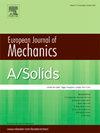各向异性第二应变梯度理论框架下fcc金属的黏聚模量和高阶弹性常数
IF 4.2
2区 工程技术
Q1 MECHANICS
引用次数: 0
摘要
各向异性第二应变梯度理论可以将结晶固体的结构不对称性纳入到其在机械载荷作用下引起的高阶弹性场波动的描述中。因此,这种理论有望提供一个足够接近固体物理现实的连续级描述。这种精确度所要付出的代价是这个理论中涉及到大量的弹性常数。使用最近发表的一篇论文中的数值[Bagherpour, V., & Delfani, M. R.(2024)]。欧元。j .机械工程。[A/Solids, 107:105377]对该理论框架下的一组fcc金属的特征长度,本文确定了其所有高阶弹性常数和内聚模量的数值。这种弹性常数和内聚模量的确定需要对fcc金属薄层的自由表面诱导重建和剪切载荷进行模拟,本文采用嵌入原子法进行了模拟。然后将这些模拟结果与相应的解析解进行比较,并计算所需的材料参数。进一步推导了所采用理论中应变-能量-密度函数的正定性条件,并讨论了本文数值确定的fcc金属弹性常数是否满足此条件。本文章由计算机程序翻译,如有差异,请以英文原文为准。
Cohesion moduli and higher-order elastic constants of fcc metals in the framework of anisotropic second strain-gradient theory
An anisotropic second strain-gradient theory can incorporate the structural asymmetry of crystalline solids into the description of the higher-order fluctuations in the elastic fields induced therein in response to mechanical loading. Such a theory is thus expected to provide a continuum-level description sufficiently close to the physical reality of solids. The price to be paid in return for this level of accuracy is the large number of elastic constants involved in this theory. Using the numerical values reported in a recently published paper [Bagherpour, V., & Delfani, M. R. (2024). Eur. J. Mech. A/Solids, 107:105377] for the characteristic lengths of a set of fcc metals within the framework of this theory, the numerical values of all their higher-order elastic constants and cohesion moduli are determined in this study. The determination of such elastic constants and cohesion moduli requires the simulation of the free-surface-induced reconstruction and shear loading of thin layers made of the fcc metals, which are carried out in this paper using the embedded-atom method. The results of these simulations are then compared to the corresponding analytical solutions, and the desired material parameters are calculated. Furthermore, the conditions for the positive definiteness of the strain-energy-density function involved in the adopted theory are derived, and subsequently it is discussed whether the elastic constants numerically determined herein for the fcc metals satisfy such conditions.
求助全文
通过发布文献求助,成功后即可免费获取论文全文。
去求助
来源期刊
CiteScore
7.00
自引率
7.30%
发文量
275
审稿时长
48 days
期刊介绍:
The European Journal of Mechanics endash; A/Solids continues to publish articles in English in all areas of Solid Mechanics from the physical and mathematical basis to materials engineering, technological applications and methods of modern computational mechanics, both pure and applied research.

 求助内容:
求助内容: 应助结果提醒方式:
应助结果提醒方式:


